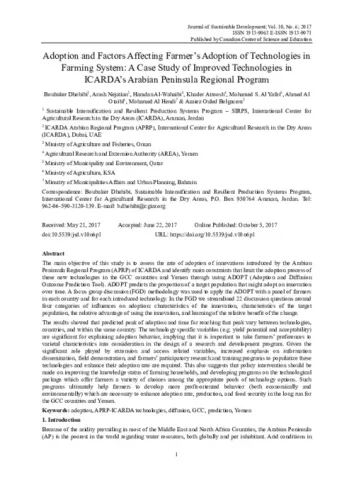Adoption and Factors Affecting Farmer’s Adoption of Technologies in Farming System: A Case Study of Improved Technologies in ICARDA’s Arabian Peninsula Regional Program

Abstract
The main objective of this study is to assess the rate of adoption of innovations introduced by the Arabian
Peninsula Regional Program (APRP) of ICARDA and identify main constraints that limit the adoption process of
these new technologies in the GCC countries and Yemen through using ADOPT (Adoption and Diffusion
Outcome Prediction Tool). ADOPT predicts the proportion of a target population that might adopt an innovation
over time. A focus group discussion (FGD) methodology was used to apply the ADOPT with a panel of farmers
in each country and for each introduced technology. In the FGD we streamlined 22 discussion questions around
four categories of influences on adoption: characteristics of the innovation, characteristics of the target
population, the relative advantage of using the innovation, and learning of the relative benefit of the change.
The results showed that predicted peak of adoption and time for reaching that peak vary between technologies,
countries, and within the same country. The technology specific variables (e.g. yield potential and acceptability)
are significant for explaining adoption behavior, implying that it is important to take farmers’ preferences to
varietal characteristics into consideration in the design of a research and development program. Given the
significant role played by extension and access related variables, increased emphasis on information
dissemination, field demonstration, and farmers’ participatory research and training programs to popularize these
technologies and enhance their adoption rate are required. This also suggests that policy intervention should be
made on improving the knowledge status of farming households, and developing programs on the technological
package which offer farmers a variety of choices among the appropriate pools of technology options. Such
programs ultimately help farmers to develop more profit-oriented behavior (both economically and
environmentally) which are necessary to enhance adoption rate, production, and food security in the long run for
the GCC countries and Yemen
